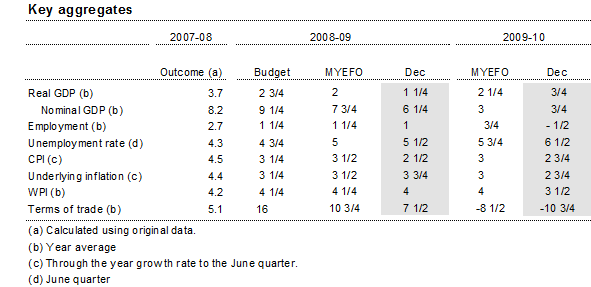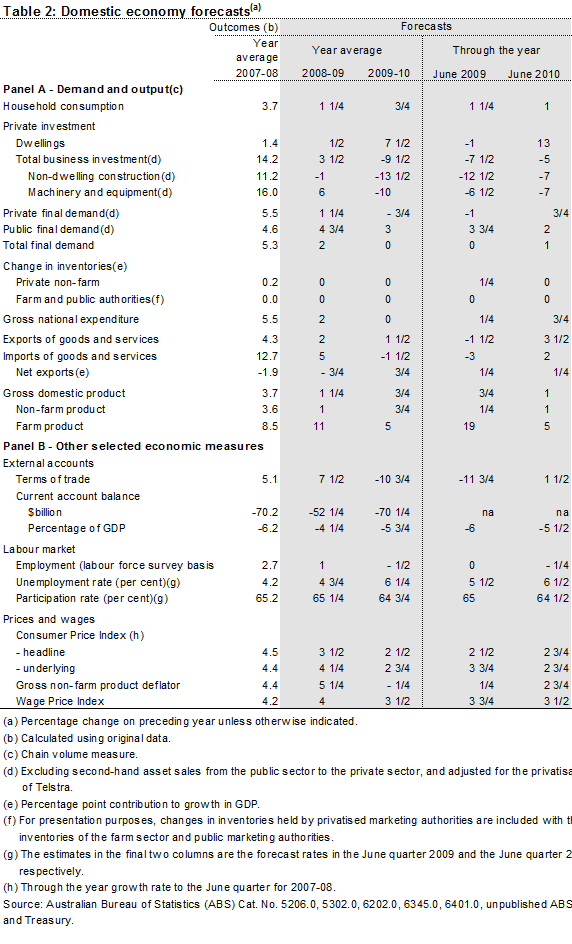There has been a significant deterioration in the outlook for the global and domestic economies since MYEFO. Most of the major advanced economies are now in, or on the brink of, recession. The risk of Australia following the rest of the world into recession has risen significantly.
Data released since MYEFO confirm that the US, Japan, Germany, the euro area and New Zealand are in recession, and the Bank of England and Bank of Canada have stated that their respective economies are entering recession. It has also become clear that emerging economies are far from being immune from the global financial crisis. China and India, while continuing to support world growth, are showing increasing signs of slowing. Shortly after the publication of MYEFO, the IMF downgraded its forecasts for world growth in 2009 from 3 per cent to 2.2 per cent, projecting the first contraction in collective advanced economy GDP in the post-war period.
The weaker world outlook, and particularly the weaker outlook for China, has seen commodity prices fall. The price of oil has fallen further from the $US68 per barrel assumed at MYEFO to around $US45. Other commodity prices have also fallen significantly and we expect contract renegotiations for iron ore and coal due around April next year to see US dollar price falls in the order of 40 to 50 per cent.
The turnaround in commodity prices is expected to cause a significant unwind of the mining investment boom of the last few years. The effects on investment will be exacerbated by continued difficulties in credit markets, with Australian firms unlikely to be able to fund investment at the levels of recent years.
With the recent relentless run of bad news on the global and domestic economies, we are yet to see the full impact of the global financial crisis, creating uncertainty as to the extent and timing of the trough in world growth. The forecasts assume a modest recovery in global conditions in late 2009 and early 2010. The forecast recovery turns on the assumption that the considerable policy stimulus being applied around the world begins to have traction by the latter half of next year.
The deterioration in global conditions runs the risk of dragging the Australian economy into recession. The December JEFG forecasts suggest an economy very close to this point. However, fiscal and monetary policy responses to date, in addition to the depreciation of the exchange rate and the fall in petrol prices, are keeping expectations of growth positive.
Real GDP growth in 2008-09 has been revised down from 2 per cent at MYEFO to 1¼ per cent. In 2009-10, real GDP growth has been revised down from 2¼ per cent to ¾ per cent. Through 2009, quarterly GDP is forecast to grow at 0.1 or 0.2 per cent. Given difficulties in forecasting specific quarters and the usual statistical error, any combination of these quarters could turn out to be negative.
Downward revisions to business investment and mining export volumes are the largest contributors to the revisions to growth, reflecting weaker world demand for commodities and more difficult financing conditions.
Household consumption has moderated a little further since MYEFO in response to additional falls in wealth and lower consumer confidence. Households are expected to continue to rebuild savings in response to falling asset prices and uncertainty about further falls. However, the Economic Security Strategy is expected to bolster consumption in the December and March quarters. Lower interest rates and fuel prices will also support consumption over the forecast period.
Table 1: Key Domestic Forecasts - December compared with MYEFO and Budget

Source: ABS Cat. No. 5206.0, 6345.0, 6401.0, 6202.0 and Treasury.
Housing investment is expected to remain weak in the short term (growing at ½ a per cent in 2008-09) in light of recent data on building approvals and housing finance. However, recent interest rate falls are expected to support a recovery in housing investment in 2009-10, with forecast growth of 7½ per cent. In line with recent market expectations, an additional 100 basis points of interest rate cuts is assumed over coming months, with all of the cuts flowing through to mortgage interest rates.
Public sector demand is expected to hold up, supported by the COAG package and recent announcements in relation to infrastructure. Less than a third of GDP growth in 2007-08 was attributable to the public sector. Around four fifths of the growth in GDP is expected from the public sector in 2008-09 and 2009-10.
A weaker economy has led to downward revisions to employment growth, with unemployment expected to rise to 5½ per cent by June 2009 and 6½ per cent by June 2010. Higher unemployment will be a drag on household consumption in 2009-10. Were the unemployment rate to rise more rapidly, this would imply lower household consumption and GDP growth than forecast.
The terms of trade is forecast to decline further since MYEFO, with an expected fall of 10¾ per cent in 2009-10 reflecting falls in most commodity prices but in particular iron ore and coal. Export volumes growth has been revised back significantly, from 6½ per cent to 2 per cent in 2008-09 and from 5½ per cent to 1½ per cent in 2009-10. Cutbacks to iron ore and coal production in response to weaker demand from the Chinese steel sector are the main contributors to lower export growth. The current account deficit is expected to widen from 4¼ per cent in 2008-09 to 5¾ per cent in 2009-10 as both lower export volumes combined with lower prices cause the trade balance to move into significant deficit.
Inflation pressures are expected to ease, with headline and underlying inflation expected to fall to 2¾ per cent through the year to June 2010. Wage pressures are expected to ease in line with the weakening labour market. Slower demand growth is also expected to ease inflation pressures over the forecast period. Operating against these effects are higher import prices flowing from the depreciation of the exchange rate. Headline inflation will be low in the short term as a result of the recent sharp falls in fuel prices.
Table 2: Domestic economy forecasts (a)
